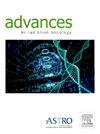A Predictive Nomogram for Development of Lymph Node Metastasis in Muscle-Invasive Bladder Cancer Following Neoadjuvant Therapy
IF 2.2
Q3 ONCOLOGY
引用次数: 0
Abstract
Purpose
Pelvic lymph node metastases (ypN+) after multiagent neoadjuvant chemotherapy (NAC) is a poor prognostic sign in nonmetastatic muscle-invasive bladder cancer (nmMIBC). We sought to create a nomogram predicting probability of ypN+ after NAC for cN0 nmMIBC and determine association with overall survival (OS).
Methods and Materials
We reviewed the National Cancer Database for patients with cT2-4N0M0 urothelial carcinoma of the bladder receiving multiagent NAC and surgery from 2004 to 2020. Following a data split, univariate logistic regression identified variables associated with ypN+ at P < .05. Eligible variables were used for multivariate logistic regression and nomogram generation. A threshold for 95% sensitivity defined high- and low-risk groups for ypN+. Fine–Gray models assessed ypN+ risk group and OS, accounting for competing risks of surgical mortality.
Results
A total of 6194 patients were identified with a median follow-up of 39.5 months (interquartile range [IQR], 20.5-67.2 months). Most patients had high-grade (97.7%) cT2 disease (70.8%) with nonpapillary urothelial histology (67.3%) and initiated NAC at a median of 41.0 days after diagnosis (IQR, 28.0-59.0 days).The nomogram included age in decades (odds ratio [OR], 0.94; 95% confidence interval [CI], 0.87–1.03; P = .172), weeks from diagnosis to NAC (OR, 1.02; 95% CI, 1.01-1.04; P = .004), nonpapillary histology (OR, 1.17; 95% CI, 0.99-1.39; P = .068), and clinical T-stage. Within the testing cohort, ypN+ was found in 392 (22.8%) high-risk and 12 (8.0%) low-risk patients (P < .001), with median OS of 36.1 and 74.0 months, respectively (P < .001). High-risk patients had worse OS despite competing risks of 30-day (subdistribution hazard ratio [SHR], 1.80; 95% CI, 1.49-2.18; P < .001) and 90-day surgical mortality (SHR, 1.68; 95% CI, 1.39-2.04; P < .001).
Conclusions
This is the first study to provide a tool for predicting ypN+ and prognosticate worse OS in primarily high-grade nmMIBC and could select patients for alternative neoadjuvant therapy and facilitate future study.
新辅助治疗后肌浸润性膀胱癌淋巴结转移的预测提名图
目的 多药新辅助化疗(NAC)后盆腔淋巴结转移(ypN+)是非转移性肌浸润性膀胱癌(nmMIBC)的不良预后征象。我们试图创建一个提名图,预测 cN0 nmMIBC NAC 后出现 ypN+ 的概率,并确定其与总生存期(OS)的关系。方法与材料我们查阅了国家癌症数据库中 2004 年至 2020 年接受多药 NAC 和手术治疗的 cT2-4N0M0 膀胱尿路上皮癌患者的数据。数据分割后,单变量逻辑回归确定了与 ypN+ 相关的变量,P < .05。符合条件的变量被用于多变量逻辑回归和生成提名图。95% 灵敏度阈值定义了 ypN+ 的高风险组和低风险组。Fine-Gray 模型评估了 ypN+ 风险组别和 OS,并考虑了手术死亡率的竞争风险。结果 共确定了 6194 例患者,中位随访时间为 39.5 个月(四分位间距 [IQR],20.5-67.2 个月)。大多数患者为高级别(97.7%)cT2 疾病(70.8%),非乳头状尿路组织学(67.3%),确诊后中位 41.0 天(IQR,28.0-59.0 天)开始接受 NAC。该提名图包括年龄(以十年为单位)(几率比[OR],0.94;95% 置信区间[CI],0.87-1.03;P = .172)、从诊断到 NAC 的周数(OR,1.02;95% CI,1.01-1.04;P = .004)、非乳头组织学(OR,1.17;95% CI,0.99-1.39;P = .068)和临床 T 分期。在检测队列中,392 例(22.8%)高危患者和 12 例(8.0%)低危患者中发现了 ypN+(P <.001),中位 OS 分别为 36.1 个月和 74.0 个月(P <.001)。尽管存在 30 天(亚分布危险比 [SHR],1.80;95% CI,1.49-2.18;P < .001)和 90 天手术死亡率(SHR,1.68;95% CI,1.39-2.04;P < .001)的竞争风险,但高风险患者的 OS 更差。结论这是第一项为主要为高级别nmMIBC提供预测ypN+和预后较差OS的工具的研究,可以选择患者进行替代性新辅助治疗,并促进未来的研究。
本文章由计算机程序翻译,如有差异,请以英文原文为准。
求助全文
约1分钟内获得全文
求助全文
来源期刊

Advances in Radiation Oncology
Medicine-Radiology, Nuclear Medicine and Imaging
CiteScore
4.60
自引率
4.30%
发文量
208
审稿时长
98 days
期刊介绍:
The purpose of Advances is to provide information for clinicians who use radiation therapy by publishing: Clinical trial reports and reanalyses. Basic science original reports. Manuscripts examining health services research, comparative and cost effectiveness research, and systematic reviews. Case reports documenting unusual problems and solutions. High quality multi and single institutional series, as well as other novel retrospective hypothesis generating series. Timely critical reviews on important topics in radiation oncology, such as side effects. Articles reporting the natural history of disease and patterns of failure, particularly as they relate to treatment volume delineation. Articles on safety and quality in radiation therapy. Essays on clinical experience. Articles on practice transformation in radiation oncology, in particular: Aspects of health policy that may impact the future practice of radiation oncology. How information technology, such as data analytics and systems innovations, will change radiation oncology practice. Articles on imaging as they relate to radiation therapy treatment.
 求助内容:
求助内容: 应助结果提醒方式:
应助结果提醒方式:


